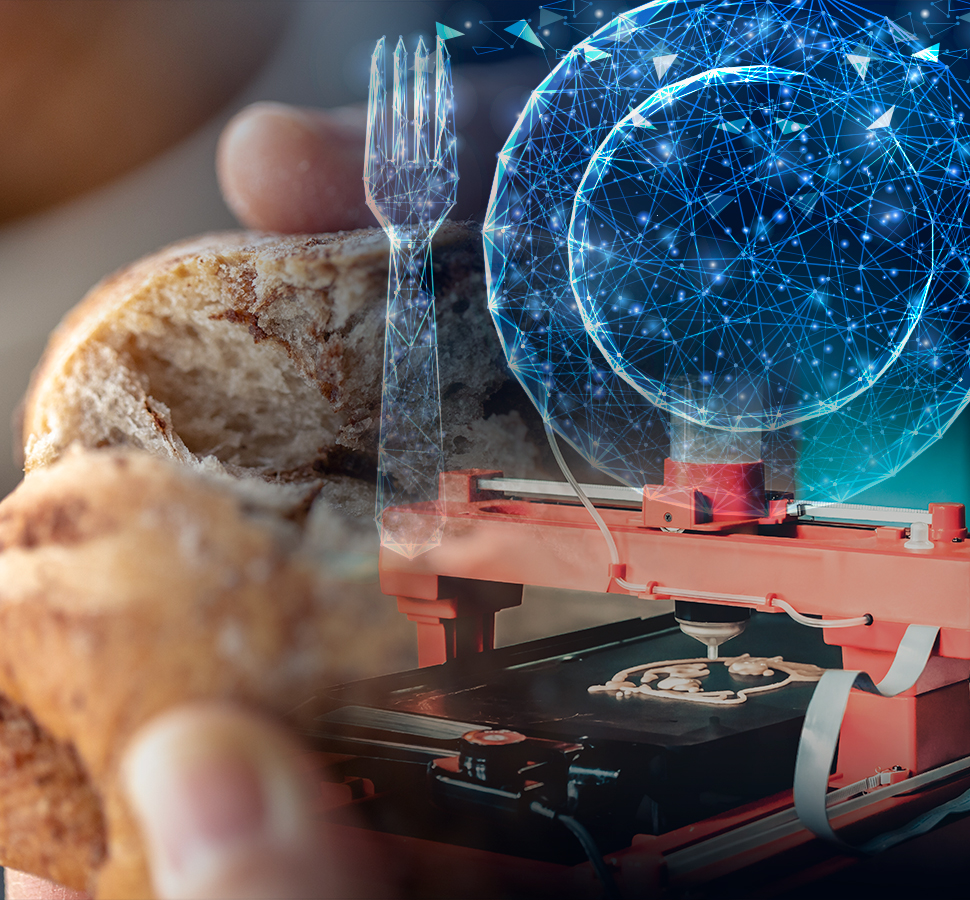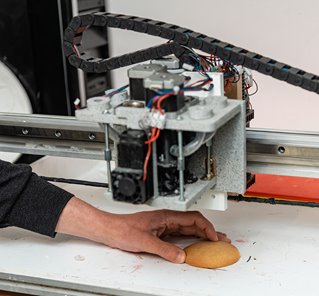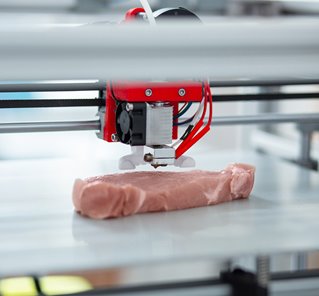3D Printing Serves Up Main Course
3D Printing Serves Up Main Course


Not quite ready for Top Chef, but new food printer can cook a meal with precision.
Hod Lipson of the Columbia University Creative Machines Lab believes a new printer his team developed could revolutionize food the way Apple’s iPod changed how the world accesses and listens to music. The team’s concept is still a bit half-baked, but it is heating up. Literally.
The lab’s digital food team has been printing food ingredients in a variety of combinations for the last 16 years. The end product was edible but raw. Jonathan Blutinger, a doctoral student in Lipson’s lab, dreamed of transforming the printer into a full kitchen appliance that could cook a delicious meal at the touch of a button. But there was a problem: The printer extruded ingredients but couldn’t cook them.
Blutinger and the team recently solved that. They can now cook food using infrared and blue lasers.
The team stumbled upon the solution by accident. The researchers had been using infrared lasers in the lab for cutting acrylic and fiberboard for different projects and wondered what would happen if they used it on dough. The laser nicely browned the outside but didn’t cook the inside. The team then tried a blue laser, thinking that a laser on another wavelength might produce different results. It cooked the dough through perfectly, just like an oven, but didn’t brown it.
“And then we thought, ‘What if we combine the two?’ ” Blutinger said, adding that the team eventually used near- and mid-infrared lasers for their browning, searing, and slightly penetrative heating, and blue for full cooking. “That was the ‘aha’ moment when we thought that maybe you just need multiple lasers with different wavelengths to do a lot of different modes of cooking. That was cool to see.”
After attaching the lasers to the printer, the team was able to adjust them for extremely precise cooking. But the printer still needed a way to control the whole process.
More on This Topic: Solving World Hunger with 3D-Printed Food
In regular 3D printing, makers typically design their end-product using CAD software, converting the 3D model into an STL (standard tessellation language) file and then passing it through a slicer engine to convert it to a G-Code file. That file contains the language that tells a printer how to build something, including the thickness, layers, extrusion rate and other specifications.
Printing food made up of many ingredients requires much more complex software than is needed for printing the one or two feed stocks used in most 3D printing applications. Almost every ingredient, for example, has a different elasticity. Peanut butter prints very differently than cream cheese. The geometries of food ingredients, such as powders, pastes, and grains, are completely different from a rectangle or cylinder. Room temperature fluctuations of just a few degrees can affect the whole process. The software has to be able to predict, control, and compensate the ingredients in real-time.
“Printing titanium is for babies,” Lipson said, half-jokingly. “Try printing chocolate. It’s very, very complex. There’s a lot of chemistry happening when you’re cooking.”
The lab is far from optimizing its food-printing software, but has developed a strong enough foundation to print and cook a number of different dishes, including chicken, salmon, hamburgers, and a seven-ingredient dessert that included layers of peanut butter, Nutella, and Graham cracker, which Blutinger claims as his favorite 3D-printed dish yet.
“I think we’ve passed the proof-of-concept stage,” he said. “In the future, there are going to be a lot of hurdles. You have to have the front-end. Right now, we mostly have the back end.”
Which brings us back to Apple. The key to the iPod’s success was the ecosystem: Tons of downloadable content that was easily stored and accessible through a well-designed platform. A food printer needs a similar ecosystem to be successful.
Editor's Choice: A Self-Aware Robot that Repairs Itself
Blutinger is pitching his concept around the food industry and talking with manufactures to develop ingredients that can be loaded into syringes, mixed proportionately, extruded properly, and cooked to perfection by the printer. The business side has to be developed before the printer can become a viable kitchen appliance.
“Right now, we’re the iPod without the music,” Lipson said.
But until then, no one in the Creative Machines lab is going hungry.
Jeff O’Heir is a science and technology writer in Huntington, N.Y.
The lab’s digital food team has been printing food ingredients in a variety of combinations for the last 16 years. The end product was edible but raw. Jonathan Blutinger, a doctoral student in Lipson’s lab, dreamed of transforming the printer into a full kitchen appliance that could cook a delicious meal at the touch of a button. But there was a problem: The printer extruded ingredients but couldn’t cook them.
Blutinger and the team recently solved that. They can now cook food using infrared and blue lasers.
The team stumbled upon the solution by accident. The researchers had been using infrared lasers in the lab for cutting acrylic and fiberboard for different projects and wondered what would happen if they used it on dough. The laser nicely browned the outside but didn’t cook the inside. The team then tried a blue laser, thinking that a laser on another wavelength might produce different results. It cooked the dough through perfectly, just like an oven, but didn’t brown it.
“And then we thought, ‘What if we combine the two?’ ” Blutinger said, adding that the team eventually used near- and mid-infrared lasers for their browning, searing, and slightly penetrative heating, and blue for full cooking. “That was the ‘aha’ moment when we thought that maybe you just need multiple lasers with different wavelengths to do a lot of different modes of cooking. That was cool to see.”
After attaching the lasers to the printer, the team was able to adjust them for extremely precise cooking. But the printer still needed a way to control the whole process.
More on This Topic: Solving World Hunger with 3D-Printed Food
In regular 3D printing, makers typically design their end-product using CAD software, converting the 3D model into an STL (standard tessellation language) file and then passing it through a slicer engine to convert it to a G-Code file. That file contains the language that tells a printer how to build something, including the thickness, layers, extrusion rate and other specifications.
Printing food made up of many ingredients requires much more complex software than is needed for printing the one or two feed stocks used in most 3D printing applications. Almost every ingredient, for example, has a different elasticity. Peanut butter prints very differently than cream cheese. The geometries of food ingredients, such as powders, pastes, and grains, are completely different from a rectangle or cylinder. Room temperature fluctuations of just a few degrees can affect the whole process. The software has to be able to predict, control, and compensate the ingredients in real-time.
“Printing titanium is for babies,” Lipson said, half-jokingly. “Try printing chocolate. It’s very, very complex. There’s a lot of chemistry happening when you’re cooking.”
The lab is far from optimizing its food-printing software, but has developed a strong enough foundation to print and cook a number of different dishes, including chicken, salmon, hamburgers, and a seven-ingredient dessert that included layers of peanut butter, Nutella, and Graham cracker, which Blutinger claims as his favorite 3D-printed dish yet.
“I think we’ve passed the proof-of-concept stage,” he said. “In the future, there are going to be a lot of hurdles. You have to have the front-end. Right now, we mostly have the back end.”
Which brings us back to Apple. The key to the iPod’s success was the ecosystem: Tons of downloadable content that was easily stored and accessible through a well-designed platform. A food printer needs a similar ecosystem to be successful.
Editor's Choice: A Self-Aware Robot that Repairs Itself
Blutinger is pitching his concept around the food industry and talking with manufactures to develop ingredients that can be loaded into syringes, mixed proportionately, extruded properly, and cooked to perfection by the printer. The business side has to be developed before the printer can become a viable kitchen appliance.
“Right now, we’re the iPod without the music,” Lipson said.
But until then, no one in the Creative Machines lab is going hungry.
Jeff O’Heir is a science and technology writer in Huntington, N.Y.







